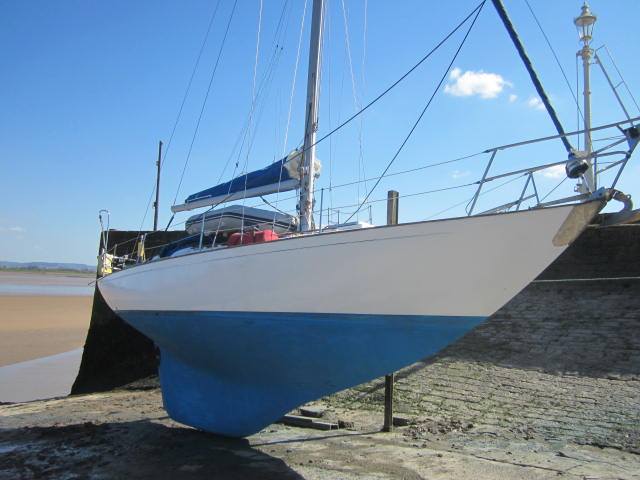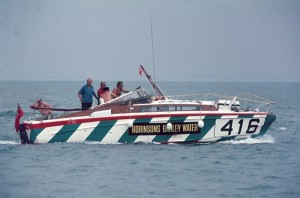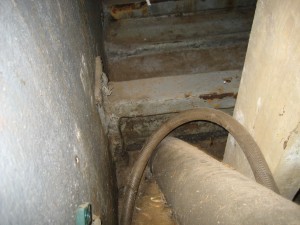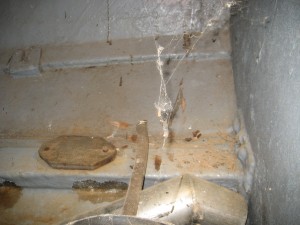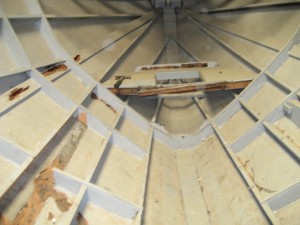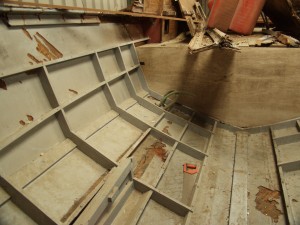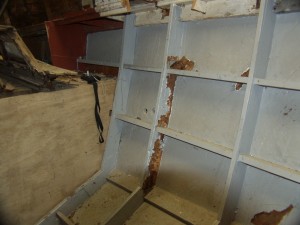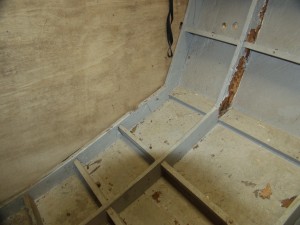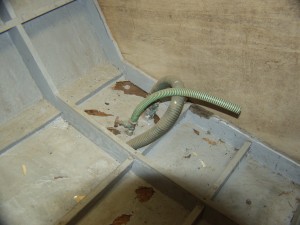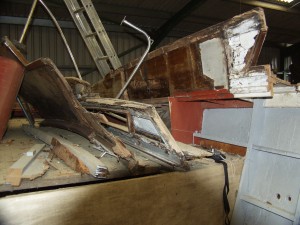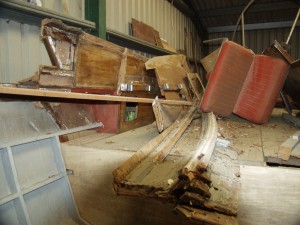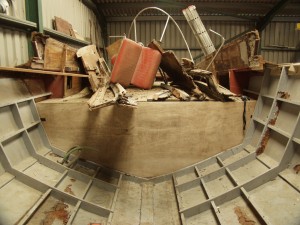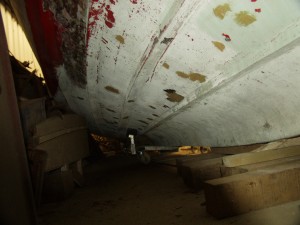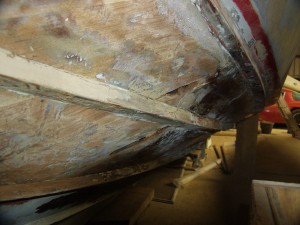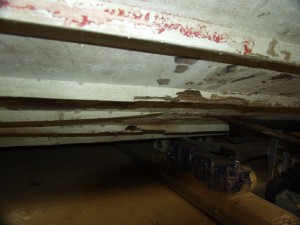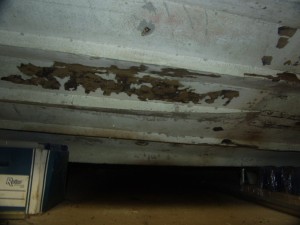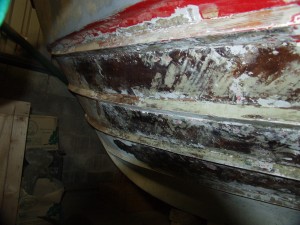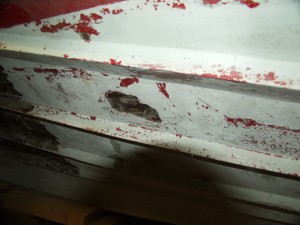“A’speranziella”
(picture courtesy of Robinsons Barleywater)
A ‘speranziella was designed by Sonni Levi to compete in the Cowes Torquay powerboat races in the early 1960’s.
Powered by twin Ford interceptor V8 petrol engines and constructed of three glued layers of diagonal (Mahogany?) veneers making a hull total thickness of approximately 1/2 inch. LOA 30ft Beam 11.6″ A lightweight fully-planing hull designed to win the then new Cowes-Torquay offshore Race for powerboats.
Below is the historic (2007 ish) state of affairs in the engine compartment of A’speranziella.
It was not possible to access the engine space and the pictures below were taken thru’ an aperture above the forward firewall.
(right click on pictures to open fullscreen in a new tab)
The hull of A’speranziella has faired somewhat worse than the engine room – lots of B&Q type timber stretchers and some truly wonderful joinery having been employed in some previous restoration.
And the less said about the deck and superstructure the better; a chainsaw having evidently been employed, presumably to improve the boat’s portability!!
However, at first look the external hull appeared reasonably well intact and undistorted, although with a number of serious patches of decay and delamination.
A’speranziella – Prognosis for restoration of this historic Powerboat…
Current situation (2011) is as follows:
The vessel is in dry storage and appears to be reasonably well supported and does not seem to have hogged (sagged in the middle) despite the removal of much of her longitudinal internal support.
The Main hull skin: composed of 3-4 layers of diagonal veneer strips approx. 6″ wide (mahogany or rpossibly red cedar, but exact species not determined from prelimary inspection). Total skin thicknes appears to be approximately half an inch, increasing towards the bottom of the hull. The skin is mostly intact but with many areas of decay and delamination (see pics above).
The interior cross-framework (ribs): of undersized timber which looks to have been acquired from a domestic DIY supplier and then roughly installed by amateurs during a previous attempt at restoration. This framework will require careful removal entirely, but only after the hull has been correctly supported from outside.
Machinery Space: not accessible, although from the pictures taken, this part of the hull appears to be mainly intact and undamaged. Complete stripping of all coatings will be required for a full condition appraisal.
Deck and superstructure: this part of the vessel will require total removal and reconstruction, having been dismantled with a chainsaw or similar implement. At least most of the material is available as patterns, however.
Machinery: a pair of engines believed to be original type Ford Interceptors complete with marine gearboxes were seen but not examined. Likewise a pair of 3 blade bronze propellers were present. propeller shafts were seen to be still installed in the boat.
Overview of restoration.
In our opinion there are two possible ways of tackling the restoration of A’Speranziella.
Method One (“Do what you can, with what you have, from where you are” – Theo Roosevelt)
1. Carefully dismantle the existing internal “framework” foreward of the main firewall, after fully supporting the hull in a purpose built jig.
2. Strip off all paint and coverings from the entire length of the hull interior. Make good the large decayed areas by use of new timberstrips, epoxied in position until a smooth level surface is achieved; all voids would need to be saturated and filled with epoxy resin / a compatible filler.
3. Lay one or two complete new layers of diagonal veneer, epoxied to the inside of the existing hull, ensuring all voids and remaining soft areas are fully saturated with resin as above. This should be continued at least up to the bilge stringer, in my opinion. (Alternatively a resin/glass sheath could be applied, but with the disadvantages already discussed).
4. Rebuild the internal framework using correctly sized timber, commencing with re-installation of the missing longitudinal members (four in number). I recommend acquisition of the original drawings to assist with this part of the work. It may well be that the existing frames can be used as patterns for new heavier laminated frames. These should be either bolted thru, or resin bonded to the inside of the skin. (if bolted, this would need to be done prior to application of the outside waterproof skin).
5. Totally strip all coverings and coatings off the outside of the hull, leaving the skin and spray-rails intact as far as possible. Repair any fractured/decayed portions of skin and sprayrails to create a sound and watertight outer skin. A covering of epoxybased material could then be applieded to render the hull watertight and protect it from further decay. There are a number of W.E S.T products and systems which may be suitable for this.
6. The deck and superstructure can then be reinstated as original; this is probably the easiest part of the rebuild although the cost should not be underestimated!.
The above procedures if conscientiously carried out should result in a seaworthy vessel although depending on the amount of additional material applied to the hull, a weight penalty would be incurred. Lack of flexibility in the bottom panels could be a problem at medium speed /heavy weather as there is normally some flexibility allowed for in this type of planing hull bottom.
Method two: start from scratch, obtain the original drawings; totally and carefully dismantle the vessel whilst retaining any usable parts such as the keel and after parts of the hull. Reconstruct the hull using modern resin glues and moulding / veneering methods to replicate the original hull as far as possible. This procedure should result in a stronger / lighter and more original hull – although the cost is likely to be very considerably higher than method one outlined above.
As discussed I will contact various people down in the West Midlands who have experience at working on this type of construction and pass on the results of my enquiries in due course. On the basis of method one above, it may be a viable proposition to simply employ an experienced boatbuilder on an hourly basis. The success of the operation being dependent of the quality of workmanship and thoroughness of epoxy saturation. Method two, would undoubtedly require a fully climate controlled indoor workspace. The above is purely an initial overview and does not in any way constitute a full repair specification.
